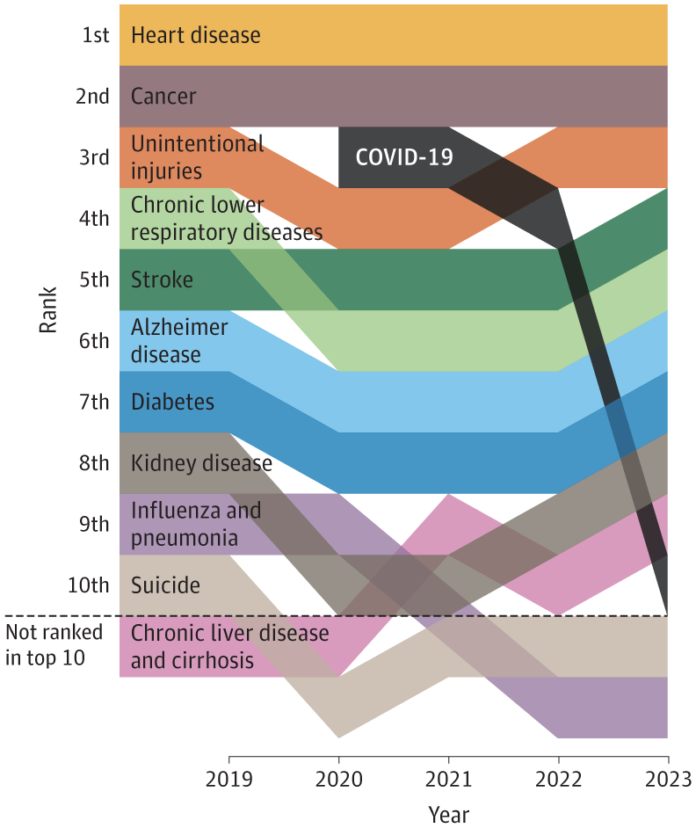Since the arrival of COVID-19 and through its pandemic phase, the estimated number of those killed by the virus has surpassed 7 million. The number is an undercount. It doesn’t reflect excess country-by-country mortality statistics. That’s because, since the beginning of the pandemic, countries have seen an unexpected rise in mortality rates that can be explained in part by the presence of the virus.
Other excess mortality factors to consider include those that are climate-related, particularly hotter than normal temperatures, the spread of vector-borne diseases and the increased frequency of extreme weather events.
COVID is associated with higher mortality rates in populations with underlying chronic conditions that by themselves may have not led to death. COVID has turned out to be the tipping point.
The Lancet in studies it has published estimates the real number of COVID deaths to be 18 million. The World Health Organization has a different set of estimates that vary between 19.1 and 36 million. Why these numbers are so different is because COVID reporting has suffered from data gaps from different parts of the planet, particularly Africa, the Eastern Mediterranean, Southeast Asia, the Western Pacific and Indigenous communities in Canada.
Even at 7 million, COVID ranks as the worst worldwide calamity of the 21st century, and rivals death totals during the 20th century from the Spanish Flu pandemic during and post World War One and the deaths that occurred as a consequence of World War Two.
This week, an article on NPR’s website states that the U.S. Centers for Disease Control (CDC) is no longer classifying COVID as a pandemic. According to Aron Hall, the Deputy Director for Science in the Coronavirus and Other Respiratory Viruses Division, “At this point, COVID-19 can be described as endemic throughout the world.”
What’s the difference between a disease being classified as a pandemic versus endemic? The differences lie in predictability, prevalence and spread. Pandemics spread rapidly across the planet, show exponential growth, and lead to large-scale disruptions to societies and economies. Endemics are characterized as diseases that are chronic, predictable and largely regional in their reach usually contained within a population group. They do not lead to large-scale economic and social disruption but rather become a constant presence that communities learn to manage.
The use of multiple COVID-19 vaccine iterations has been key to moving the classification of the virus from pandemic to endemic. Hall notes that COVID remains “a very significant problem but one that can now be managed against the backdrop of many public health threats and not as sort of a singular pandemic threat.” Hall believes COVID can be best described at this stage as being endemic but with periodic epidemics. He goes on to state, “Those epidemics can vary in terms of their timing and magnitude. And that’s exactly why ongoing vigilance and surveillance is critical.”
The NPR article cites other epidemiologists who disagree with Hall and the CDC’s latest reclassification of COVID. They point to recent statistics that show COVID on the rise throughout this summer in the Northern Hemisphere at a significant rate. Katelyn Jetelina, a Masters in Public Health and PhD. in Epidemiology and Biostatistics, who publishes a blog called Your Local Epidemiologist, is cited in the NPR article stating “There’s still a lot of unpredictability with this virus, and a lot of scientists including myself think it’s going to take at least a decade for SARS-CoV2 [COVID-19’s scientific name] to find this really predictable pattern. I hope that over time it will fade into the background. But we’re just not there yet.”
By introducing the term endemic, the CDC is creating confusion state some scientists who point out that malaria and tuberculosis are both classified as endemic. In 2022, malaria infected close to a quarter billion people and killed more than 600,000. In 2021, tuberculosis infected more than 7.8 million and led to more than 1 million deaths. The latest COVID data shows that the rate of deaths has declined since 2021 but that 50,000 are still dying because of the virus each year, mostly the elderly.
Then there is the incidence of Long COVID which is still poorly understood and leaving the infected with lifetime disabling conditions. A New York Times article this week cites a study appearing in the journal Nature Medicine which states that the “cumulative global incidence of Long COVID is around 400 million individuals, which is estimated to have an annual economic impact of approximately $1 trillion—equivalent to about 1% of the global economy.”
The thing we have going for us today is the incredible surge in research into COVID vaccines that target the evolving variants. Coronaviruses like SARS-CoV2 change rapidly, and fortunately, our science and technology are keeping up. New vaccines targeting the latest variants are being produced and approved in rapid succession much the way the annual influenza vaccine continues to go through its many annual iterations.
That’s why the CDC recommends everyone from age 6 months and up be vaccinated this fall and winter in the same way it recommends influenza vaccinations. The 2024-25 vaccines will be out this and next month. COVID is expected to peak along with the flu over the winter.
Just in case you think the need for vaccinations is overblown, in January 2024, U.S. COVID deaths were 2,600 weekly. That was down considerably from three years earlier with weekly deaths ten times greater, and even more falling ill from being infected. The reported number of deaths dropped COVID from number 3 in 2020-21 to no longer in the top 10 causing death (see the graph appearing at the beginning of this article).
Vaccine fatigue, however, has set in for the U.S. and Canada which may make Hall’s prediction of periodic epidemics a reality. Based on recent fall and winter CDC data, only 22% of adult Americans, and 14% of eligible children received COVID vaccinations. For those adults who were diagnosed and hospitalized with COVID, only 11% were vaccinated. Comparable data from Canada reports that 18.2% of Canadians across all ages received the most recent COVID vaccines.
If you have been reading the above, you should now be convinced that COVID vaccinations represent the most effective way to prevent infections and death from the virus because who likes being sick or dying from something that today can be prevented or minimized?









